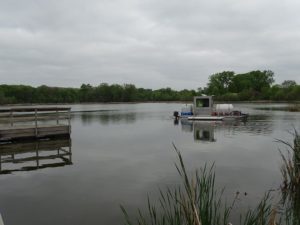Lake Cornelia Alum Treatment

Project Purpose
Lake Cornelia and Lake Edina are shallow lakes with poor water quality that are on the state’s impaired waters list for excess nutrients. The projects will work to control nutrient levels (phosphorous) in Lake Cornelia and Lake Edina. Because water flowing out of Lake Cornelia eventually flows into Lake Edina, reducing the amount of nutrients coming out of Lake Cornelia will improve Lake Edina and downstream water resources.
Alum treatment

When aluminum is applied to a lake as a solution of alum (aluminum sulfate), it forms an insoluble aluminum hydroxide floc that settles to the lake bottom. The aluminum binds with phosphorus in the sediment to prevent it from recycling back into the water column. Conducting the alum treatment before aquatic plants are reestablished in the lake allows the aluminum floc to reach the sediment more evenly.
HAB Aquatic Solutions is applying the alum from a treatment barge, pictured above. The alum treatment for Lake Cornelia was completed on May 22nd. Go to our Projects page for more information on the project.
What is alum?
Alum (aluminum sulfate) is a nontoxic liquid. Its use in lakes began in the early 1970’s and is used to reduce the amount of phosphorus in the water. Phosphorus is the nutrient that fuels algae growth. Reduced phosphorus levels can lead to lower amounts of algae. Alum is most often used to control phosphorus release from the lake bottom sediments (internal loading).
